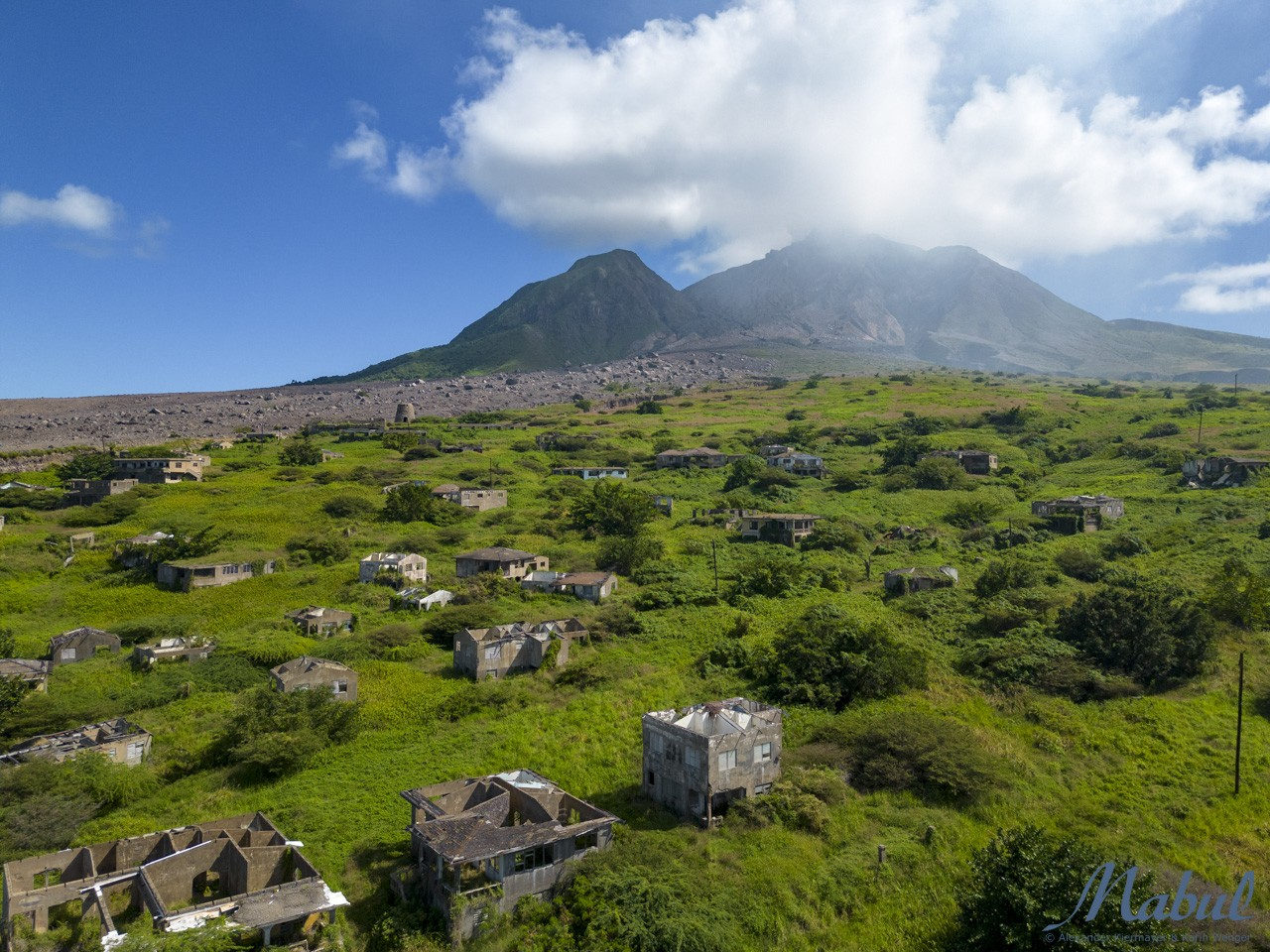Share post now
Opinion
In the shadow of the volcano
23.03.2023, Climate justice
Sandy beaches, rum and colourful fish. That is the Caribbean from the travel catalogue. What is not mentioned is that the Caribbean islands are especially vulnerable to natural phenomena.

© Karin Wenger
As we sail along Montserrat's west coast, it suddenly hits me – an awful stench. Perhaps a flying fish that jumped on deck without being noticed? No. It stinks of rotten eggs. And then we see them – little clouds of sulphur billowing from the mouth of the volcano and wafting on the wind to us out at sea. The Soufrière Hills volcano is in eruption, and has been for almost thirty years now.
Its 1995 eruption took the islanders by surprise. Having shown no sign of life since the 16th century, the Soufrière Hills volcano suddenly awoke from a deep sleep after 270 years. The volcano began spewing ash and lava, and the capital Plymouth, which lies on the western side of the volcano, had to be evacuated. Most of the 11,000-plus islanders moved away. As Montserrat is still a British Overseas Territory, many went to England, where they got help.
Herself a teenager at the time of the eruption, Vernaire Bass, too, left her homeland back then. "Not only was the infrastructure destroyed, but there was no longer any work or a future for us," recalls Bass, who now heads the island's National Museum, amongst other things. Besides, she says, the volcano was not the only danger. "Starting in June every year, we have to countenance the possibility that a hurricane could destroy all that we have built up. That means living in constant uncertainty. The upshot is that many islanders – not just here, but all around the Caribbean – suffer from PTSD, Post Traumatic Stress Disorder, because of this." In 1989, for example, Hurricane Hugo tore across the Caribbean and caused extensive devastation, including in Montserrat. The capital Plymouth and the island's infrastructure were rebuilt over six years, there were new schools and a new hospital; and when everything was restored, the volcano erupted. "Without the help from England,” Vernaire recounts, “the island might well be deserted today. We simply wouldn't have had the money to rebuild everything."
Montserrat is not the only volcanic island in the region. Here, the Caribbean plate collides with other plates, creating friction and causing repeated earthquakes and volcanic activity. In the region of the Antilles in particular, which includes Montserrat, the interaction between the North and South American and Caribbean plates is such that extreme tensions can build up here. The hurricane season runs from June to November every year. In 2022, 14 major storms and eight hurricanes swept across the Caribbean. They caused major damage to some islands. Cuba, for instance, was hit by Hurricane Ian last September. More than three million Cubans were directly affected and tens of thousands lost their homes. Climate researchers tell us that if the temperature rises by two degrees compared to the pre-industrial era, the probability of hurricanes, storms and severe flooding in the Caribbean would increase fivefold. As a future scenario, that would mean the destruction of habitat and the displacement of millions of people.
Montserrat, too, was hit by a massive hurricane last year. Hurricane Fiona swept across the island on 16 September 2022. The worst affected was Plymouth, the former capital, which the volcano had already destroyed. The volcano has been in constant eruption since 1995. Over recent years, its dome has repeatedly grown by hundreds of metres, only to collapse again. The last dome collapse occurred in 2010. Two thirds of the island, including Plymouth, and a radius of ten nautical miles around the southern part of the island still constitute a restricted zone. It is thanks to special authorisation that we are able to visit what remains of Plymouth. Here, where there was once bustling activity, now lie just ruins, enveloped in an eerie silence. The volcano has literally incinerated and swallowed up the city. Only the top floors of some three-storey buildings are still visible; where a long cruise ship pier once stood, only the tiny rump of a pier can be seen – the volcano has ejected so much material that the coastline has moved a hundred metres into the sea. Where there was once water, there is now new land.
The volcano is currently being monitored around the clock by a group of international scientists from the Montserrat Volcano Observatory. One of them is José Manuel Marrero, a Spanish volcanologist. He says: "The danger of a new and massive eruption is real. We just don't know when it will take place."
Despite this, Vernaire Bass returned to the tiny Caribbean island three years ago, after more than two decades in the UK. "I was longing for my homeland and wanted to play a part in the island's development," she says. But the island has changed. Of its once 11,000-plus residents, only 3,000 now remain. Everyone knows everyone else, corruption is rife, and new ideas often come to nothing, owing to the inflexible attitudes of a handful of powerful and influential families. On occasion, Vernaire regrets having returned home. Yet, she says, the volcano has given her a gift: "It has taught me to be adaptable. I can survive anywhere, provided I have food and shelter. That's perhaps the difference between us islanders and Europeans: the ever-present danger makes us resilient and able to survive."

© zVg
Karin Wenger
Karin Wenger
Karin Wenger was South Asia and South-East Asia correspondent for Radio SRF from 2009 to 2022, based in New Delhi and Bangkok. She published three books about her time in Asia. Since last summer, she has been sailing the Caribbean with her partner and writing about forgotten topics and world regions. More information is available at www.karinwenger.ch or www.sailingmabul.com